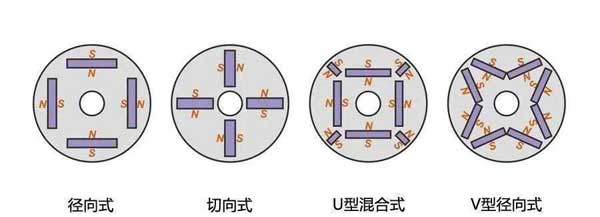The components of the permanent magnet synchronous motor: stator, permanent magnet steel rotor, position sensor, electronic commutation switch, etc.
Permanent magnet synchronous motors have the advantages of simple structure, small size and light weight. , Small loss, high efficiency, high power factor, etc.It is mainly used for high-performance servo drive systems that require fast response, wide speed range and precise positioning.
For permanent magnet synchronous motors, a 120° phase shift is applied to the stator windings in the three-phase sinusoidal voltage mode, thereby generating a rotating magnetic field around the rotor.
The rotor tries to align with the rotating stator field.Therefore, when the rotor and stator magnetic fluxes are separated by 90°, the torque generated is the largest, and when the magnetic fluxes are aligned, the torque is zero.Finally, the rotor speed is equal to the stator frequency.Therefore, this motor is called a synchronous motor.The speed of the motor can be controlled by adjusting the frequency of the three-phase power supply.
Permanent magnet synchronous motors are better than brushless DC motors in some aspects, including smaller torque ripple, low audible noise, and better ability to work at low speeds.
On the other hand, the structure of the motor is usually very complicated and requires complicated control algorithms.The motor is usually equipped with a quadrature encoder, quadrature encoder to detect rotor position and speed feedback; sometimes Hall sensors are used to detect the starting position.

In a brushless DC motor, each phase of the stator is fed with a series of trapezoidal voltages, so mixing together will produce a rotating magnetic field with a rectangular spatial distribution, which helps to understand the simplified bipolar model. This type of motor The basic principle.
The feed coil UW generates a magnetic field, so the rotor transmits torque in its NS direction and starts to rotate.It should be noted that first, the two magnetic fields move 90° and rotate after 30°.After the stator is commutated, the stator magnetic field generated in the new form moves out of the rotor magnetic field by 120°.As explained, the rotor must follow the stator magnetic field, so the displacement is reduced to 60°, and a new commutation is performed at this time.And the situation continues to repeat, so a 360° rotation can be obtained.
The correct time for the power supply of the commutation coil is determined by the three Hall sensors placed in the coil.Therefore, as long as the boundary is usually moved between 60° and 120° and 90° with the magnetic field as the center,
Six different forms can produce maximum efficiency.It must be remembered that the maximum torque can be obtained when the stator magnetic field and the rotor magnetic field are offset by 90°.Obviously, the torque produced by the brushless DC motor has obvious fluctuation characteristics.And its working principle determines the advantages of the permanent magnet synchronous motor is also obvious.